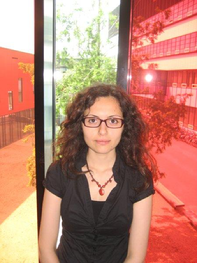Measurements of strong correlations in the transport of light through strongly scattering materials
Promotion date: September 5.
Promotor: Prof.dr. Allard Mosk and Prof. dr. Willem Vos
| A study on light transport through multiple scattering random photonic media is described. According to theory, one can synthesize an incident field that gets completely transmitted through the scattering material. An arbitrarily synthesized incident field is a superposition of orthogonal fields that are completely transmitted and completely reflected from the scattering material. Theory predicts that the number of orthogonal fields that are completely transmitted is much smaller than the ones that are completely reflected. This leads to the transmitted fields being a superposition of a small number of independent fields and makes them correlated. One can study these correlations by studying transmission matrices of scattering media. A large part is devoted to measuring and analyzing optical transmission matrices of strongly scattering random photonic media with the aim of observing and studying the correlations in the measured transmission matrices. We studied the singular value histograms of the measured matrices and saw deviations from singular value histograms of random, uncorrelated matrices, indicating that the fields transmitted are indeed correlated. Moreover, we studied the intensity fluctuations in the speckle transmitted through a strongly scattering material and observed that the measured speckle intensity histogram is in line with mesoscopic transport theory predictions, confirming that the sample supports a small number of fields that gets completely transmitted through. In addition, we described an experiment where we control light transport through a random photonic TiO2 paint layer by performing wavefront shaping with binary amplitude modulation, where we blocked the portion of the field that interferes destructively with the rest of the field at a pre-determined target area behind the scattering sample. This way, we enhanced the intensity at the target by removing part of the light that is sent to the sample. |
Was your work theoretical in nature or are applications also visible at the horizon?
I carried out both application and fundamental research oriented experiments, with the emphasis on studying fundamental physics. To analyze and interpret the experimental data I made use of existing theories. This helped me to develop a good understanding of the theory, in addition to developing myself as an experimenter. My technical skills as an experimenter are developed a great deal. Now I feel confident as a professional researcher.
My research on controlling light transport through strongly scattering materials - such as paper or an egg shell or human skin - has many thinkable applications, especially in the biomedical field. These can be realized in the more far away future, I am sure of.
Were there some decisive moment you recall during your thesis project?
The first was when we decided to put the emphasis on studying the open transmission eigenchannels. Also the collaboration with a research group from the University of Southampton I remember very well.
Measuring the first results - the experiments really showing correlated behaviour - was exciting but at the same time made me feel somewhat anxious. I spent a long time analyzing the data and making tests to make sure that the observed correlations were a result of the phenomenon we are looking for and were not results of some unforeseen artefacts. When the results were in accordance with our own numerical model and an analytical model that was recently developed in Yale University - and when the expected correlations showed up time and time again in an expected way - I was certain and reassured.
Were your results published?
One chapter from my thesis has been published in Optics Express. Currently we are working on converting three of the other chapters into publications. I also presented the results in the format of oral and poster presentations at several international conferences.
In what way did you develop, as a scientist and researcher?
During my PhD, I considerably improved my experimental skills as well as data analysis skills. Also I learnt many technical skills and I developed a good knowledge of my field.
Also I learnt that communication on various levels is important to make progress in scientific research. First of all one has to communicate with colleagues within and external to one’s own field, bringing you further in developing ideas and designing good experiments from them. Also communicating to people outside the scientific community is important, to bring your ideas and the work of the institute to a broader public.
What are your future plans?
I am going to work at ASML in the metrology research group. There are several options to choose from, including new methods of mask alignment and surface profile measurements. I would like to see my efforts applied to real-life situations sooner than in my PhD project. I guess by making the step to industry I will feel the satisfaction of my work much sooner.
What, in your opinion, is important for Mesa+ to stay successful in future?
Being part of the Mesa+ Strategic Research Orientation group Applied Nanophotonics, we had monthly meetings among the various optics groups in the university, learning what other researchers were working on and discussing the recent results. We were encouraged to contribute to these meetings by small poster presentation sessions. This contributed to the interaction of various research groups, which is very important in my point of view. This can be taken even to a broader scale, I believe. The contact with the photonics groups was important for my project.
In addition, I believe that more interaction can take place between groups from different fields. For example a closer interaction between the chemistry groups and photonics groups in Mesa+ can benefit both sides, since fabrication of novel structures is very important for photonics research.

